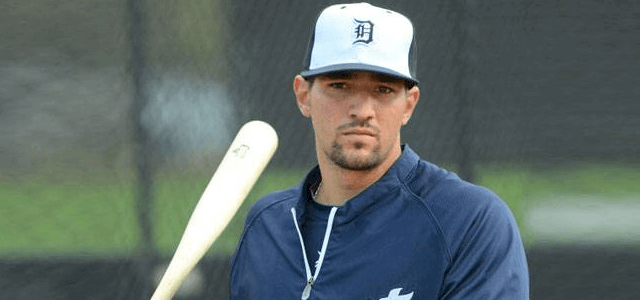
Nick Castellanos is entering his third season as the starting third baseman for the Detroit Tigers.
With two full seasons under his belt, Nick Castellanos approaches his “platform year”—his final pre-arbitration season—with questions hanging over his head. Will the long-heralded Tiger prospect become the star he was supposed to be? Can he learn how to play his position?
While other Tiger regulars, including key cogs such as Miquel Cabrera, Ian Kinsler, Victor Martinez, and Justin Verlander, are well into the portions of their careers when age-related performance declines can be expected, Castellanos is still surprisingly young—just twenty-four. But he’s been a fixture at the hot corner for what seems like a long time already. And when some older players go into an inevitable decline, Castellanos is one of the small number of young regulars who will have to improve to offset any lost production from the veterans.
There are real questions whether Castellanos, who was a left fielder in the minors, can adequately handle third base defensively. He made a few small strides last year, but he still makes many routine plays look challenging. He doesn’t have the sure hands nor the quick reflexes necessary at the hot corner. His arm is adequate if he makes the plays—but that’s a big if.
Third base is a position where you might sacrifice offense for good defense, but that can’t be the case for such a poor defender as Castellanos. He’s supposed to turn into a third baseman of the other type—a hitter whose bat is strong enough to make up for his poor fielding. The problem is that he hasn’t yet proven he is that kind of hitter.
If and when he does, you can envision his career path with the Tigers quite clearly—when Victor Martinez retires (which won’t be long), and Miguel Cabrera starts to wear down, Miggy can become the DH, and Castellanos can be moved to first base, where his defensive limitations won’t matter so much. (Detroit will have to find another third baseman). Then when Miggy retires, Castellanos would take over at DH—the position he’s most suited for.
That assumes Castellanos can fill the bill as a middle-of-the-order RBI machine—but he hasn’t yet shown that to be the case. He hit eleven homers in 2014 and fifteen in 2015. Playing almost every day and usually batting sixth or seventh behind a very potent middle of the order, he drove in sixty-six runs the first year and seventy-three the second. His OPS improved from .700 to .722. But his strikeouts increased from 140 to 152 while his walks jumped only slightly, from thirty-six to thirty-nine.
A continuing slight improvement of this sort is not likely to catapult Castellanos into a star player ever. And there is no sign in his tool set or his mechanics that he is likely to do much better than that. Baseball Prospectus rates his chances of a breakout season at 5 percent but his chances of improving at 53 percent. Even that doesn’t exactly inspire confidence. If you don’t expect an improvement at his age, when would you ever?
Luckily, Nick C is just one minor cog in an offensive machine whose first five spots should be very productive again. So there is not an extreme amount of pressure on him now. But it’s going to be building over this year and years to come.
When he does make contact, he is learning to hit all over the field—which is sort of the Tigers’ club ethos. That’s a good sign. But either his contact rate has to increase, his power has to grow, or (least likely of all) he needs to become at least an adequate fielder. This may be the season we get a more definitive answer on his future.


